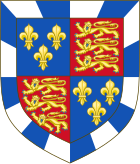Beaufort family
| House of Beaufort | |
|---|---|
 Armorial of Beaufort |
|
| Country | Kingdom of England |
| Parent house | House of Plantagenet (legitimised) |
| Titles |
|
| Founded | 1373 |
| Founder | John Beaufort, 1st Earl of Somerset |
| Current head | David Somerset, 11th Duke of Beaufort |
| Cadet branches |
|
The House of Beaufort is an English noble family, which originated in the fourteenth century and played an important role in the Wars of the Roses in the fifteenth century. The name Beaufort refers to Montmorency-Beaufort [France, département de l'Aube, Champagne], once the possession of John of Gaunt, 1st Duke of Lancaster, third son of King Edward III.
The family is descended from John Beaufort (1373–1410), John of Gaunt's son by his then-mistress Katherine Swynford. Gaunt married Swynford in 1396, and their children were legitimized by Richard II and Pope Boniface IX. They had three other children, also Beaufort: Henry, Thomas, and Joan.
The Beauforts were a powerful and wealthy family from the start, and rose to greater power after their (half-)brother and uncle became King Henry IV in 1399. However, in 1406, Henry IV decided that although the Beauforts were legitimate, their genetic line could not be used to make any claim to the throne. John Beaufort had already been created Earl of Somerset in 1397. His second son John became the first Duke of Somerset in 1443.
The third son, Henry, became a bishop, Lord Chancellor, and a Cardinal; the fourth son, Thomas, became Duke of Exeter; and the daughter, Joan, married Ralph de Neville, 1st Earl of Westmorland. Joan had the most pedigree, her many descendants including the Dukes of York, Warwick the "Kingmaker", the Dukes of Norfolk, the Dukes of Buckingham, the Earls of Northumberland, and Henry VIII's last queen, Catherine Parr.
...
Wikipedia
